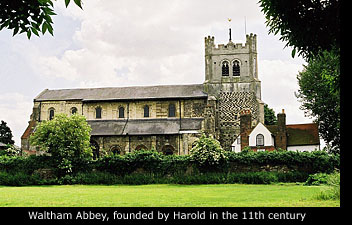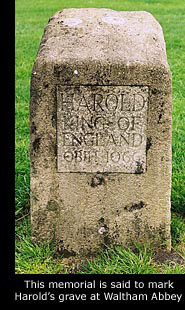|
Every schoolchild knows the legend of King Harold's death at the Battle of Hastings in 1066. Not so well known is Harold's rise to the throne of England – without a drop of Royal blood flowing in his veins.
Harold's predecessor, Edward the Confessor (1042-1066) had been denied automatic accession to the throne when the Norwegian King Cnut defeated his father, Ethelred the Unready. Cnut became King in 1016 and was succeeded in turn by his sons Harold Harefoot and Harthacnut; but it was short-lived dynasty. Harthacnut died suddenly in 1042 making the English crown vulnerable to legitimate Scandinavian contenders.
However, the powerful, influential and manipulative landowner, Godwine Earl of Wessex, feared a loss of status should a strong Viking succeed to the throne. To ward off this threat, he persuaded the Witan to offer the crown to the Saxon heir, Edward. Characteristically, Godwine then took full advantage of Edward's weaknesses and insecurity and virtually ruled England himself.
An unsuccessful attempt to overthrow Edward in 1051 led to exile for Godwine and his family – but they returned to England the following year at the head of a large army. The family's former titles were duly restored and Godwine’s dominance continued until his death in 1053 after which his son, Harold Godwineson, became Earl of Wessex and took the same position ‘above’ the king.
What makes this period particularly fascinating for us is Harold’s link with Bishop’s Stortford, specifically with the first Saxon owner of the Manor of Esterteferd (Stortford), Eddeva Pulchrima. Various chronicles reveal her as a Saxon woman of exceptional beauty, sometimes called Edith the Fair or, more popularly, Edith ‘Swan-neck’.
Harold’s relationship with Edith probably began around 1045 after he became Earl of East Anglia with a manor at nearby Dunmow. Chronicles of the time refer to him as her 'licensed' or 'unlicensed' lover and she bore him several children. In modern terminology she was his mistress, a ‘title’ that only really applied after his marriage in 1065 to Ealdgyth (Edith), widow of the Welsh king, Gruffydd. Gruffydd had twice waged war on England (in 1057 and 1063) and was defeated by Harold on both occasions. Before he could make a third attempt, the battle-weary Welsh cut off his head and delivered it to Harold as a sign of submission.
 Harold’s marriage to Ealdgyth was more a contrivance than a bond of love. As King Edward’s right-hand man and chief executive, he knew that the King’s marriage to his sister (also named Edith) in 1045 remained unconsummated. This convenient absence of a bloodline heir made the wily Harold prime contender to the throne. But in order to fulfil his great ambition he needed the support of other earls – and found the perfect solution in Gruffydd’s widow, Ealdgyth, sister to the earls Edwin and Morcar of Mercia. Their support was practically guaranteed should he marry her and should she became queen when Edward died. He did not have long to wait. Harold’s marriage to Ealdgyth was more a contrivance than a bond of love. As King Edward’s right-hand man and chief executive, he knew that the King’s marriage to his sister (also named Edith) in 1045 remained unconsummated. This convenient absence of a bloodline heir made the wily Harold prime contender to the throne. But in order to fulfil his great ambition he needed the support of other earls – and found the perfect solution in Gruffydd’s widow, Ealdgyth, sister to the earls Edwin and Morcar of Mercia. Their support was practically guaranteed should he marry her and should she became queen when Edward died. He did not have long to wait.
Edward the Confessor died on the 5th January 1066 and Harold, administrator of the kingdom for so long and proven a worthy leader in battle, was prime candidate to succeed him. Imminent threats to the kingdom, not least by his brother Tostig, meant the Witan had little choice but to elect Harold as King.
Understandably, this did not sit well with Duke William of Normandy who, some years earlier (according to Norman chroniclers), had been promised the English throne by Edward in the absence of an heir. Harold, too, had endorsed his accession only two years before. The rest, as they say, is history – 1066 and all that...
Perhaps the biggest mystery surrounding Harold is the location of his last resting-place. Earliest records say that William afforded him no ceremony after the Battle of Hastings and buried the body on the seashore. However, informed chroniclers say that Edith the Fair identified Harold by marks on his body known only to her; facial recognition being practically impossible as he had been felled by an arrow in the eye. Norman cavalry then mutilated the body – decapitating him after first chopping off his right leg and part of the left.
With William’s permission, Edith is said to have taken Harold's remains to the abbey he had founded at Waltham (Waltham Abbey) for burial – initially by the high altar then, later, in another part of the church. But since that time historical events have further clouded the issue. Henry VIII’s order to dissolve the monasteries in the 16th century resulted in the destruction of much of Harold’s beloved abbey – leaving intact only the nave and aisles of the Church of the Holy Cross.
If Harold was buried near to the high altar then his tomb was effectively in the open air. But its position was known and in the early 19th century, following investigations into his true burial site, the tomb was opened. Found to be empty, added impetus was given to the theory that the body lay buried elsewhere – and not in another part of Waltham Abbey church. It was, in fact, at Bishop’s Stortford.
Yet another story relates how Edith the Fair had Harold's body brought secretly to Stortford from Waltham and buried in the original Saxon church on Windhill (now the site of St Michael’s). Edith then fled to Chester where she spent the rest of her life in obscurity, and on her death in 1086, so the story goes, permission was granted for her secret burial alongside Harold in St Michael’s church.
Further credence was given to this account in 1831 when workmen, constructing a vault in the centre of the nave close to the tower of St Michael's, unearthed an early Norman pudding stone coffin which, although unopened, was assumed to contain Edith's remains. The tomb was re-sealed and remained so until shortly after the arrival of Rev Francis Rhodes in 1850. When St Michael's latest incumbent granted permission to a parishioner to open a family vault beneath the nave the excavation revealed a further vault containing three pudding stone coffins of early Norman origin.
 Keen to solve the mystery of King Harold's true burial place, Rhodes permitted the opening of the largest of these coffins - in which the remains of a man of great stature, believed to be Harold, were revealed. However, bearing in mind that Harold's body was reportedly mutilated at the Battle of Hastings, it is somewhat surprising that records of the day make no mention as to whether this newly discovered skeleton was fully intact or not.
Keen to solve the mystery of King Harold's true burial place, Rhodes permitted the opening of the largest of these coffins - in which the remains of a man of great stature, believed to be Harold, were revealed. However, bearing in mind that Harold's body was reportedly mutilated at the Battle of Hastings, it is somewhat surprising that records of the day make no mention as to whether this newly discovered skeleton was fully intact or not.
Meanwhile, the other two coffins remained unopened, although Rhodes later inferred that one contained the remains of Harold's wife Queen Ealdgyth (Edith), while the other held the skeleton of the king's mistress Edith the Fair - a theory rigorously upheld by antiquarians of the time. So, though never proven conclusively, it remained a possibility that Harold, England's last Saxon King, lay buried in St Michael's Church.
Then a further discovery made around 100 years later appeared to identify another location as Harold's true resting-place. He was born around 1022 in the south coast village of Bosham (now situated in West Sussex) and as a boy attended mass in the parish church there. This building still remains and houses, at the foot of the chancel steps, the 11th century tomb of King Cnut's young daughter who had drowned in a local millstream. In the 1950s, during the installation of a heating system in the church, a Saxon tomb was discovered alongside that of the young girl.
When this second tomb was opened it was found to contain parts of a skeleton. Missing were the head, the right leg and part of the left leg, remains conforming to the vivid description of Harold's mutilation at Hastings. Added evidence that this was the most likely site of Harold's final resting-place arises from the fact that, after the Conquest William made Bosham his private estate. Perhaps in order to prevent Harold's grave from becoming a shrine for Saxons he may have had the body buried within the parish church. If this account is true then a Hertfordshire mystery remains - whose bones are incarcerated in the three Norman coffins beneath St Michael's Church at Bishop's Stortford?
|
|
